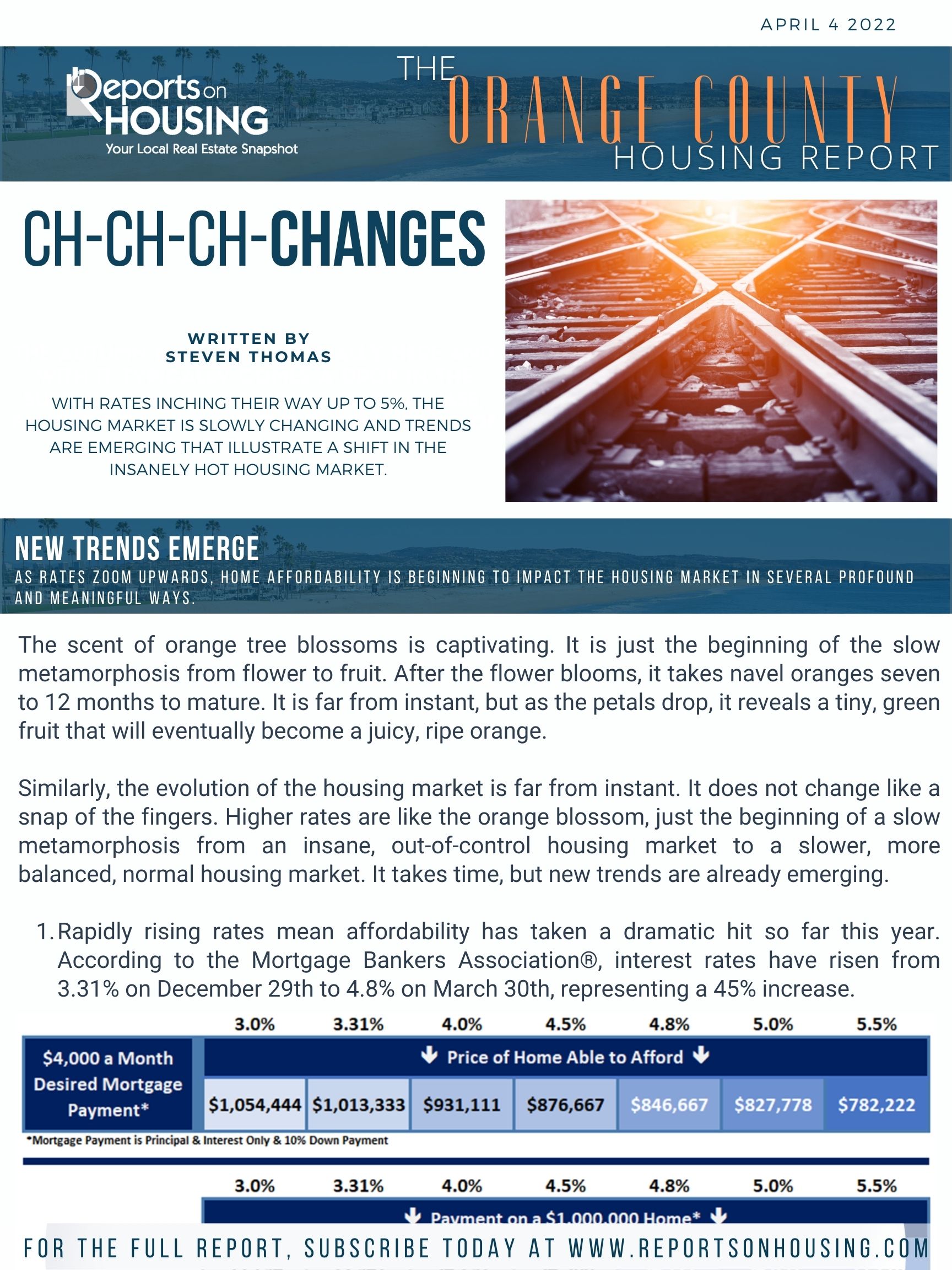WITH RATES INCHING THEIR WAY UP TO 5%, THE HOUSING MARKET IS SLOWLY CHANGING AND TRENDS ARE EMERGING THAT ILLUSTRATE A SHIFT IN THE INSANELY HOT HOUSING MARKET.
1.Rapidly rising rates mean affordability has taken a dramatic hit so far this year.
According to the Mortgage Bankers Association®, interest rates have risen from 3.31% on December 29th to 4.8% on March 30th, representing a 45% increase. The purchasing power for buyers has rapidly eroded in such a short period of time. For a buyer looking to put 10% down and desiring a $4,000 per month payment, at the end of December they were looking at a $1,013,333 home. Today, that same buyer is now looking at homes just below $850,000. Another way of looking at it is how much more the payment is on a $1 million home. At 3.31% with 10% down, the payment would be $3,947 per month versus $4,772 per month at 4.8% today. That is an additional $884 per month, or $10,608 per year. Persistent higher rates will eventually diminish demand and, ultimately, throttle back the housing market. The pool of buyers able to purchase shrinks as rates rise.
2. Significantly fewer homes are being placed on the market this year compared to the average prior to COVID.
Last year there were 2,368 missing FOR-SALE signs in Orange County compared to the 3-year average between 2017 to 2019, 6% less. Yet, through the first three months of 2022, there are 1,866 missing signs, down 18%. Originally, the extremely anemic inventory was preventing homeowners from entering the fray. Today, it is more than that. Owners are more than happy staying put in their homes. They are acutely aware that home values are continuing to rise, that mortgage rates have substantially climbed, and that the underlying mortgage loan on their home is substantially lower than today’s 4.8% rate. In doing the math, homeowners are opting to stay put. Many homeowners who purchased several years back have refinanced to below 3% and have realized substantial appreciation. Yet in calculating their monthly mortgage payment and property taxes if they sell and purchase a larger home, the monthly difference can be staggering. As a result, many homeowners are opting to stay.
3. Demand, a snapshot of the number of new escrows over the prior month, has been substantially muted this year.
Today’s demand is at 2,286 pending sales. So far this year demand has risen from 1,295 during the first week of January to 2,286 today, an increase of 991 pending sales. The 3-year average rise in demand prior to COVID (2017 to 2019) was 1,277, or 29% higher than today. Last year’s demand reading was at 3,162 pending sales, 38% higher than today. Today’s level is the lowest reading to start the 2nd quarter of a year since 2007. Demand has been muted all year. A big reason for muted demand readings is the acute lack of homes available to purchase. Simple economics: “You cannot buy what is not for sale.” True demand, the number of buyers in the marketplace, is considerably higher than tracked demand based upon escrow activity, yet is impossible to gauge other than home showing activity and the number of offers generated on homes today. Anecdotally, reports from the real estate trenches detail a reduction in the number of multiple offers real estate agents are receiving. Over time, if mortgage rates persist at these higher levels with duration, then demand will continue to remain muted compared to prior years even with more homes coming on the market. It is important to note that the strongest demographic patch of first-time home buyers ever, millennials, is making its way through the real estate market right now. The surge of prime first-time home buyers aged 32 years old occurs between 2020 and 2024. That demographic was added on top of an increase in buyer activity during COVID thanks to record low mortgage rates. Those record rates are gone, but there are still an astonishing number of millennials contributing to demand.
The Orange County housing market has been running at an insane pace since July 2020. Yet, with mortgage rates climbing from 3.31% at the end of December to 4.8% today, new trends have emerged that will ultimately lead to a market downshift as long as higher rates endure.


